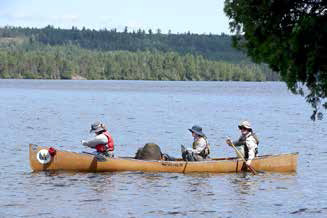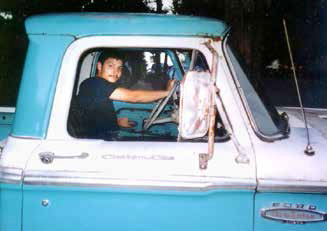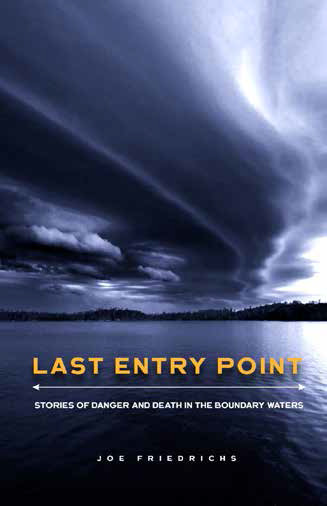GRAND MARAIS — Most people who visit the 1.1-million-acre Boundary Waters Canoe Area Wilderness, and Quetico Provincial Park, just across the Ontario border, probably don’t think much about danger and death on their trip, but Joe Friedrichs thinks maybe they should.
At least a little bit. Friederichs is the author of a new book out this month, “Last Entry Point: Stories of Danger and Death in the Boundary Waters.”
While it has a foreboding title and an ominous cover photo, the book is much more than doom and gloom. It has plenty of that, to be sure, as Friedrichs digs beyond the headlines of a half-dozen deaths and disappearances in the BWCAW in recent decades, along with tales of near death, including one of Friedrichs’ own.
There is death and danger in the book from hypothermia (usually caused by an unexpected dunk into cold water), lightning strikes, drowning, wildfires, getting lost, high winds, falling trees, medical emergencies, miscalculations, mistakes and bad luck. We hear from search-and-rescue personnel, eyewitnesses, weathered woodspeople, lodge owners, survivors, relatives and more.
Yet, Friedrichs said he wrote the book not just as a chronicle of what has happened, but also to prevent future deaths from occurring in Minnesota’s beloved wilderness. His goal is to get people to go into the BWCAW more prepared to handle whatever they might face, and to at least know what potential problems may arise. To respect Mother Nature’s ability to turn nasty. To be aware. To be careful.
“These narratives of tragedies and hazards may seem calculated to warn BWCA enthusiasts away from their dreams,’’ Friedrichs writes. “But in fact, they are meant to encourage all paddlers and hikers to think through what could happen and to be prepared for all contingencies so that, ideally, they return with their own tales that are memorable for only the best of reasons.”
Friedrichs, 41, grew up in Mason City, Iowa, and attended the University of Montana in Missoula. He studied journalism and was a reporter in Oregon for several years before moving to Grand Marais and becoming news director at WTIP radio. He left that post last year to focus on a new venture, the Paddle and Portage (paddleandportage. com) podcast and online magazine. The magazine, which features the ability to turn the page on a computer or mobile device, is available to Paddle and Portage subscribers on the 20th of each month.
Friedrichs calls Paddle and Portage “a unique perspective on the intersection of news, adventure and storytelling from and about the Boundary Waters.”
While Friedrichs received some negative feedback as he was researching the book from people who believe death and bad memories are better left undisturbed, so far, he said, response to the book has been positive.
We asked Friedrichs to tell us a little more about what went into the book and why: Q: What drew you into reporting/writing?
A: I’ve been in journalism since my sophomore year of high school when I joined the school newspaper. Telling stories and talking to people about what is happening in a community is all I’ve ever wanted to do. It’s the way I most authentically connect with people, through storytelling.
Q: What attracted you to the North Shore, Grand Marais and the BWCAW area? And what’s kept you here?
A: I was pulled up here by the remoteness and the fishing. And those have played a huge role in what’s kept me here. I also like the challenges of small-town living. It’s a mad world no matter where you roam. So at least there’s lake trout to help pass the time.
Q: What caught your interest about accidental deaths in the wilderness? Why are deaths and near-death experiences in a beautiful, usually happy place interesting?
A: I was drawn to these stories initially because they had no depth, no storyline. The press releases from law enforcement were so vague. I was curious about who these people are who died in the wilderness I visit so frequently. We can’t learn much from a press release about someone dying, but we can from the story of what brought them there and then analyzing the circumstances of how they died.
Q: An ”entry point” is where people start their trip in the BWCAW. How did you decide on “Last Entry Point’’ for the title?
A: My good friend Ann Possis in Grand Marais came up with the title. She’s been helpful in supporting my writing and other projects for as long as I’ve been up here. She’s gold.
Q: Why did you find the story of Billy Cameron, who died of hypothermia in Tuscarora Lake in 2020, so intriguing? What made his story the genesis of your book?
A: It was the spring of COVID and there was so much confusion in the world at that time. I was one of the only people coming into the radio station, WTIP, at the time, and when the press release about Billy dying came in, I just wanted to learn more. I found Nataly (Yokahanis, Cameron’s girlfriend) on Facebook and asked her if she wanted to share some stories about Billy and why he loved the Boundary Waters. And she had so many stories to share! It was a moment of opening my mind to, “What other stories are there that could be shared about people who’ve died in the Boundary Waters?”
Q: You come back to Nataly Yokahanis often in the book, even though she was not witness to the event. Why were her feelings, even years after the tragedy, so impactful for you?
A: Nataly was the first person to open the door into the personal side of how a death in the BWCA has ripple effects. She was the person who let me know it’s OK to reach out when someone is grieving and in immense emotional pain. She was vulnerable. She opened my mind to the possibility that other people might want to share their stories, too.
Q: You had already started writing the book by that time, but how did your own traumatic experience on the Temperence River in May 2023 impact you and the book?
A: The initial manuscript was submitted by then, so it was a revision to add that section in. After it happened, my three friends and I continued our fishing and canoe trip. On day three of the trip, we could finally loosen up a bit about the situation. The boys were like, ‘Who gets the royalties if the guy writing the book about people who’ve died in the Boundary Waters actually dies in the Boundary Waters?’ We never did figure that out on our trip, though I’ve since updated a life insurance plan and will to account for that type of thing.
Q: There’s a difference between bad luck and bad decisions, and it seems like there is some of both in these tales of death and danger in the BWCAW. Is one more prevalent than the other?
A: Bad decisions play a big part in the cold-water situations, including my own from the Temperance River. That situation could have been avoided. That’s the point in sharing these stories, so people can learn from them. When it comes to things like lightning strikes and trees blowing down in heavy wind, there’s bad luck involved in that or things beyond our control, but even then, there are preventative measures.
Q: Should wilderness visitors get more training/ education on more than just BWCAW rules and regulations, maybe more on the perils/risks that exist?
A: The Forest Service does a great job of talking about what rules not to break on a camping trip to the Boundary Waters. They talk a lot about what not to do. They don’t talk much about what you can do proactively to stay safe. It would be good to see them do more of this.
Q: Have you changed your behavior, or your outlook, on going into wild places after reporting these harrowing stories?
A: It took a personal brush with death in the Boundary Waters to really shift my approach, and that’s why I wanted to share my story from the Temperance. People don’t need to go through what I did to learn about how serious this is. Even after hearing all those stories for nearly two years, it still took that event from the river to nail home the idea that this can happen to me as easily as it can someone else.
In the fall of 2023, about five months after the incident on the Temperance, I was paddling my solo canoe in some huge waves on a big lake in the BWCA. I wasn’t afraid out there riding the rollers, but I had a heightened awareness on safety. I was completely present in the canoe in that moment.
Q: You included a lot of BWCAW history in the book, from conservationists Sigurd Olson and Ernest Oberholtzer to famed forest researcher Bud Heinselman. Why was it important for you to tell their stories, too?
A: The entire book is a history book, in the sense that we can learn from the events of the past. Adding the stories of canoe-country legends was an opportunity to help people appreciate that we have this protected wilderness and that it needs to be traveled with respect for not just the place, but for those who came before us.
Q: What’s your next book going to be about?
A: I want to write the biography of Cathy Wurzer, the public media icon in Minnesota. She turned me down the first time I asked her, but I’m still hopeful we can make something happen. Cathy is someone I admire a great deal, and I know a lot of people in Minnesota and beyond do too. I’d love to write a book about her. … I also have another book proposal I’m working on about the Boundary Waters, specifically, what’s under the Boundary Waters. Minerals, gases, things like that. There are so many layers to that story, literally and figuratively. I’m doing the reporting on that now.
About the book “Last Entry Point, Stories of Danger and Death in the Boundary Waters,” by Joe Friedrichs 209 pages, Minnesota Historical Society Press, available at local bookstores and online $19.95; e-book $9.99 Also by the author: “Her Island: The Story of Quetico’s Longest Serving Interior Ranger”

Joe Friedrichs is the founder of the Paddle and Portage online magazine and podcast. He’s also the author of a new book, “Last Entry Point: Stories of Danger and Death in the Boundary Waters.” Contributed / Joe Friedrichs

Campers headed into the BWCAW. A new book, “Last Entry Point,” highlights what can and has gone wrong to campers in the wilderness, including death by hypothermia from falling into unexpectedly cold water, even when the air temperature is warmer. Jed Carlson / 2023 file / Duluth Media Group

Nathan Williams, a senior at the University of Minnesota Morris in 2004, in the 1966 Ford pickup truck he and his father refurbished. Williams went missing in October 2004. The truck was found along a forest road near remote Hog Creek in Lake County, on the edge of the BWCAW. Not a sign of Williams has ever been found. His story is one of several in the new book “Last Entry Point: Stories of Danger and Death in the Boundary Waters.” Contributed / Dave Williams

.jpg)









